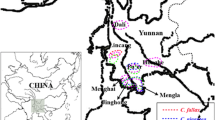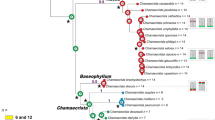Abstract
Chromosome numbers were determined for 125 accessions of 92 taxa of Mimosa from all five of Barneby’s (Mem New York Bot Gard 65:1–835, 1991) taxonomic sections. For 69 species, 1 subspecies and 8 varieties, chromosome numbers are presented for the first time, for 6 species and 1 variety previously published data have been confirmed and for 3 species and 2 varieties different numbers were found. Results show that 74% of the accessions were diploid (2n = 2x = 26) and 26% polyploid, these mostly tetraploid (2n = 4x = 52) but with two triploid (2n = 3x = 39). These results double the number of Mimosa species for which the chromosome count is known from less than 10% previously reported to more than 20%, representing an important advance in the cytotaxonomy of this legume genus. These results together with literature data show that ca. 78% of Mimosa species are diploid. Polyploids are present in most of the taxonomic sections and in different lineages across the genus. No particular chromosome number is restricted to a given section or lineage. A possible relation between geography, species distribution, polyploidy and invasiveness was detected, however, further studies based on more accessions, especially from higher latitudes, are required before firm conclusions can be drawn.

Similar content being viewed by others
References
Alves MAO, Custódio AVC (1989) Citogenética de leguminosas coletadas no estado do Ceará. Rev Bras Genet 12:81–92
Barneby RC (1991) Sensitivae censitae. A description of the genus Mimosa Linnaeus (Mimosaceae) in the New World. Mem N Y Bot Gard 65:1–835
Bessega C, Hopp HE, Fortunato RH (2008) Toward a phylogeny of Mimosa (Leguminosae: Mimosoidae): a preliminary analysis of southern south American species based on chloroplast DNA sequence. Ann Missouri Bot Gard 95:567–579
Camargo-Ricalde SL, Grether R, Martínez-Bernal A, García-García V, Barrios del Rosal S (2001) Especies útiles del género Mimosa (Fabaceae-Mimosoideae) en México. Bol Soc Botan Mex 68:33–44
Caramori PH, Androcioli Filho A, Leal AC (1996) Coffee shade with Mimosa scabrella Benth. for frost protection in southern Brazil. Agrof Syst 33:205–214
Dhillion SS, Camargo-Ricalde SL (2005) The cultural and ecological roles of mimosa species in the Tehuacan-Cuicatlan Valley, Mexico. Econ Bot 59:390–394
Du Puy DJ, Labat J-N, Rabevohitra R, Villiers J-F, Bosser J, Moat J (2002) The Leguminosae of Madagascar. Royal Botanic Gardens, Kew
Federov A (1969) Chromosome numbers of flowering plants. Academy of Sciences of the USSR, Leningrad
Goldblatt P (1981) Cytology and the phylogeny of the Leguminosae. In: Polhill RM, Raven PM (eds) Advances in legume systematics, vol I. Royal Botanic Gardens, Kew, pp 263–427
Lewis G, Schrire B, Mackinder B, Lock M (2005) Legumes of the world. Royal Botanic Gardens, Kew
Lorenzi H (2000a) Árvores brasileiras: manual de identificação e cultivo de plantas arbóreas nativas do Brasil. Instituto Plantarum, Nova Odessa
Lorenzi H (2000b) Plantas daninhas do Brasil. Instituto Plantarum, Nova Odessa
Lowe S, Browne M, Boudjelas S, De Poorter M (2000) 100 of the world’s worst invasive alien species: a selection from the global invasive species database. The World Conservation Union (IUCN), Auckland
Missouri Botanical Garden (2009) IPCN (index to plant chromosome numbers). http://mobot.mobot.org/W3T/Search/ipcn.html. Acessed December 2009
Polhill RM, Raven PH, Stirton CH (1981) Evolution and systematics of the Leguminosae. In: Polhill RM, Raven PH (eds) Advances in legume systematics, vol 1. Royal Botanic Gardens, Kew, pp 1–26
Rivera-Arce E, Chávez-Soto MA, Herrera-Arellano A, Arzate S, Agüero J, Feria-Romero IA, Cruz-Guzmán A, Lozoya X (2007) Therapeutic effectiveness of a Mimosa tenuiflora cortex extract in venous leg ulceration treatment. J Etnopharmac 109:523–528
Seijo G (1993) Números cromosómicos en especies Argentinas del género Mimosa (Leguminosae). Bol Soc Argent Bot 29:219–223
Seijo G (1999) Chromosome studies in Argentinean species of Mimosa. Cytologia 64:241–246
Seijo G (2000) Números cromosómicos de especies de Mimosa (Leguminosae) de Paraguay. Bonplandia 10:163–167
Seijo G, Fernández A (2001) Chromosome numbers of some southernmost species of Mimosa L. (Leguminosae). Cytologia 66:19–23
Simon MF (2009) Systematics and evolution of Mimosa L. (Leguminosae) and the assembly of a Neotropical plant diversity hotspot. PhD Thesis, Oxford University, London
Simon MF, Proença C (2000) Phytogeographic patterns of Mimosa (Mimosoidae, Leguminosae) in the Cerrado biome of Brazil: an indicator genus of high-altitude centers of endemism? Biol Conserv 96:279–296
Simon MF, Grether R, Queiroz LP, Skema C, Pennington RT, Hughes CE (2009) Recent assembly of the Cerrado, a neotropical plant diversity hotspot, by insitu evolution of adaptations to fire. Proc Nat Acad Sci USA 106:20359–20364
Stebbins GL (1971) Chromosomal evolution in higher plants. Addison-Wesley, Reading
Acknowledgments
We thank CNPq (Conselho Nacional de Desenvolvimento Científico e Tecnológico, Brazil) for a PhD grant to the first author and financial support and the Millenium Seed Bank of the Royal Botanic Gardens, Kew, Euan James, Sergio de Faria, Joan Sutherland, Tiina Sarkinen, Carolyn Proença, Rosaura Grether, Sara Camargo-Ricalde, John Wood, Chris Fagg and Luciano de Queiroz for provision of samples and assistance in the field.
Author information
Authors and Affiliations
Corresponding author
Rights and permissions
About this article
Cite this article
Dahmer, N., Simon, M.F., Schifino-Wittmann, M.T. et al. Chromosome numbers in the genus Mimosa L.: cytotaxonomic and evolutionary implications. Plant Syst Evol 291, 211–220 (2011). https://doi.org/10.1007/s00606-010-0382-2
Received:
Accepted:
Published:
Issue Date:
DOI: https://doi.org/10.1007/s00606-010-0382-2




